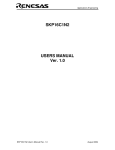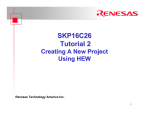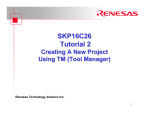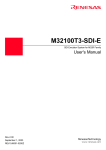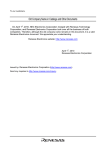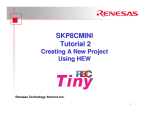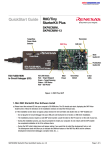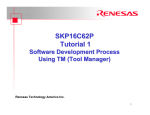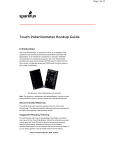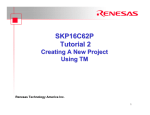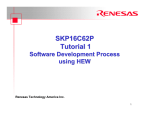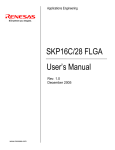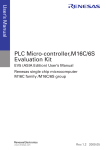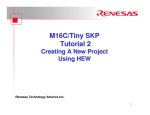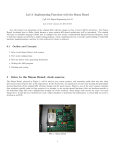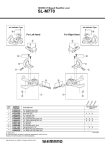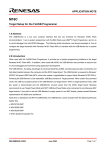Download 16C26_quickLarge_v2 (Page 1)
Transcript
QuickStart Guide SKP16C26 StarterKit Plus 8 Characters x 2 Lines LCD Power LED Reset Switch LCD Contrast Analog Adjust (R16) Thermistor M16C/26 MCU (M30262F8GP) User LEDs User Switches RTA-FoUSB-MON In-Circuit Debugger (ICD) Target/Bus Power Mode Selector ICD LED Status: Red – Target Stopped Green – Target Running Status – ICD Status Red – ICD Power Figure 1. SKP16C26 SKP16C26 StarterKit Plus QuickStart Guide Page 1 of 5 1. SKP16C26 StarterKit Plus Software Install a) Please insert the enclosed CD into your computer’s CD-ROM drive. The CD should auto-start, displaying the SKP Picker Install Screen. Follow the directions in the installation windows to install the Renesas tools. i) If the installation screen does not appear, please browse the CD root folder and double-click on “SKP-Installer.exe”. – Do not plug the In-Circuit Debugger into your USB port until instructed to in Section 2, USB Driver Installation. – The installation process requires a valid SKP serial number. Locate the label on the PC board or on the side of your box. – During the installation process, you may be prompted to restart your computer. Do not restart until the SKP installer has completed installation of all of the software items. – During the SKP install, dialog boxes will appear asking if you would like to install the development tools or not. The development tools will allow you to evaluate the different features of the M16C/26 MCU and the software development environment (debugger, compiler, linker, etc…). 2. USB Driver Installation When you connect the RTA-FoUSB-MON In-Circuit Debugger (ICD) to your computer for the first time, Windows will recognize this new device and will request the drivers. Follow the steps below to install the drivers. Administrator privileges are required to install the driver on a Windows 2000/XP machine. a) Plug one end of the USB cable into the RTA-FoUSB-MON and the other into a USB socket on your PC (the supplied USB cable is keyed for the mini USB connector on the FoUSB-MON). The “Found New Hardware Wizard” window will appear. b) If using Windows XP, skip to step 2 c); otherwise, click <Next>. c) Verify the (Recommended) option is selected and click <Next>. d) Select “Specify a location” and leave all other options un-checked; click <Next>. e) Browse to the “C:\MTOOL\FOUSB\USB Drivers” folder. f) Select the file “fousb.inf” and click <Open>. g) Click <Ok> to install the USB Driver. – For Windows XP, a dialog box is displayed warning that the driver has not been tested for Windows XP compatibility. Please disregard this warning and continue driver installation. – You can verify that the driver is installed properly by looking at how fast the Status (yellow) LED is blinking on the RTA-FoUSB-MON. If the driver is loaded correctly, the Status LED will be blinking once every second. If not, the Status LED will blink 2-3 times a second (if you continue having driver installation problems, see SKP16C26 User’s Manual, Appendix A. Troubleshooting). SKP16C26 PC with Windows® 98SE, 2000, Me, or XP Mini USB Cable ICD 10-pin Target Cable Figure 2. SKP16C26 System Connectivity SKP16C26 StarterKit Plus QuickStart Guide Page 2 of 5 3. Demo Program The kit ships with a demo program that runs on the board when connected to the ICD (RTA-FoUSB-MON). a) If not already done in step 2a), plug one end of the USB cable into the RTA-FoUSB-MON and the other into a USB socket on your PC. b) Connect the RTA-FoUSB-MON to the SKP16C26 Board using the supplied ribbon cable. The power light of the board should come on. If the power light on the SKP16C26 board does not come on, check the Power Mode switch on the RTA-FoUSB-MON and verify that it is set to the “USB” position. c) Press the reset switch to run the demo program. – The LCD on the board will display a welcome message (adjust LCD contrast as needed). After a few seconds, “RT1: xxxx, AN0: xxxx” will be displayed on the LCD. – The LED’s will blink sequentially (back and forth). – The LED flash rate is controlled by the Analog Adjust (R16) potentiometer (which is connected to the ADC’s AN0 input). The 10-bit ADC value is also shown on the LCD as AN0. d) Turn the Analog Adjust clockwise or counter-clockwise. This alters the flash rate of the LEDs, and increases or decreases the AN0 value shown on the LCD. e) Press the pushbutton switches S1, S2, or S3. This will stop the sequential blinking and the LEDs. The LED associated with the pushbutton switch (i.e., S1 - Red LED, S2 - Yellow LED, and S3 - Green LED) will light up when the switch is held down. 4. HEW (IDE) Quick-Start HEW integrates various tools such as the compiler, assembler, debugger, and editor into a common Graphical User Interface. To learn more on how to use HEW, open the HEW manual navigator on your computer (Start > (All) Programs > Renesas High-performance Embedded Workshop > Manual Navigator). a) Launch HEW from the Start menu (Start > (All) Programs > Renesas High-performance Embedded Workshop > High-performance Embedded Workshop). b) In the “Welcome!” dialog box: i) Verify “Create a new project workspace” is selected. ii) Click <OK>. c) In the “New Project Workspace” Dialog box: i) Verify the “CPU family” is set to “M16C”. ii) Select “M16C/26 StarterKit Plus” (Figure 3). iii) Enter “skptest26” for the Workspace Name (the Project Name will auto fill to “skptest26”). iv) Click <OK>. Figure 3. New Project Workspace in HEW d) On the “M16C/26 StarterKit Plus - Step 1” Window: i) Click <Next>. e) On the “M16C/26 StarterKit Plus - Step 2” Window: i) Select “Test”. ii) Click <Finish>. f) In the “Project generator information” Window: i) Click <Ok>. g) Click the “Build” icon, , to compile, assemble and link the project. HEW will look similar to Figure 4. Figure 4. HEW with the skptest26 project compiled h) After ensuring there are no errors, proceed to section 5, KD30 Debugger Quick-Start. SKP16C26 StarterKit Plus QuickStart Guide Page 3 of 5 5. KD30 (Debugger) Quick-Start a) Connect the SKP16C26 to the PC as shown in Figure 2 (described in detail in steps 3a) and 3b) above). b) Click on the debugger button to launch the KD30 debugger from HEW. The “Init” dialog box should open (Figure 5). c) The first time you run KD30, you will have to define the target: i) Click <Refer…>. ii) Highlight “M30262F8.mcu” and click <Open>. iii) Select “USB” and click <OK>. – If you get an error, check connectivity. – If the message “We should download new firmware” is displayed, click <OK>. Figure 5. KD30 Init Window d) After initialization, the KD30 Program Window will appear and our program, “skptest26.X30”, is automatically downloaded. The KD30 Program Window should look like Figure 6. e) Click the “Go” icon to start the program. This program is similar to the Demo program, but the LEDs do not blink. The LED’s are off unless any of the user switches are pressed. f) Click the “Stop” icon to halt the program. If you now click the “Go” icon, the program will resume execution from the point it stopped. g) Exit KD30 by selecting “File > Exit” from the pull-down menu in KD30. Figure 6. KD30 Program Window after download of skptest26 h) Exit HEW by selecting “File > Exit” from the pull-down menu in HEW. 6. Downloading (re-loading) the Demo Program using the Flash-over-USB™ Programmer When we ran KD30, the original demo program was erased and the SKP16C26 board was programmed with a different program. You can use the Flash-over-USB™ Programmer to restore the original demo program. a) Connect the SKP16C26 to the PC. (Described in detail in steps 3a) and 3b) above). b) Start the Flash-over-USB™ Programmer (Start > (All) Programs > RENESAS-TOOLS > Flash-over-USB Ver. x.xx > FoUSB Programmer) or double-click on the “FoUSB” icon on your desktop). c) The first time the FoUSB Programmer is opened on your computer: i) Under Select MCU Family, click on “M16C/20 Series”. ii) Under Select MCU Part Number, click on “M30262F8”. iii) Click <Ok>. iv) Click <OK> as requested until you are returned to the Flash-over-USB main menu. d) Every other time the FoUSB Programmer is opened: – If the “Unlocked” window appears, click <OK>. e) Click <Open> when the Flash-over-USB main menu appears. SKP16C26 StarterKit Plus QuickStart Guide Page 4 of 5 f) Browse to the “C:\MTOOL\SKP16C26\Sample_Code\SKP\ SKPDemo\Release” folder. g) Select “SKPDemo.mot” and click <Open>. i) When the ID Code dialog box appears, click <OK>. h) Click <Program> to open the Program Flash window. i) Click <Program> to download the demo program. j) When the FoUSB dialog box “Program completed Successfully” appears, click <OK> (Figure 7). k) Click <Exit> to close Flash-over-USB Programmer and the demo program should start. For more information on how to use the Flash-over-USB™ Programmer, click on the “Help” button. Figure 7. Flash-over-USB™ Programmer Main Menu after loading the Demo Code 7. What’s the next step? After you have completed this quick-start procedure, please review the tutorials that came with the kit. The tutorials will help you understand and jumpstart the software development process using Renesas’ development tools. You can access the tutorials from the Start Menu (Start > (All) Programs > RENESAS-TOOLS > SKP16C26 > Tutorial 1 – Development Process or Tutorial 2 – Creating a New Project) or from (Start > (All) Programs > RENESAS-TOOLS > SKP16C26 > Document Description), which also lists other documents that come with the SKP. To check for any updates to the StarterKit Plus, use the (Start > (All)Programs > RENESAS-TOOLS > SKP16C26 > Check for Kit Updates) shortcut. This will take you to a kit-specific page on the Renesas website which provides links to any available update downloads. 8. HEW3/C-Compiler The High-performance Embedded Workshop User Manual will show you how HEW3 integrates various tools such as the compiler, assembler, debugger and editor into a common Graphical User Interface. To access the manual on your computer, go to the HEW menu (Start > (All) Programs > Renesas High-performance Embedded Workshop > Manual Navigator). The NC30WA Entry version of the C-compiler is included in the SKP and has no time expiration, but has the following limits: 1. Assembly optimization and debug options are not available. 2. The tool to analyze the inspector or variable is not available. 3. Some advanced tool functions, such as the map viewer, are not available. 4. The software comes without support or warranty. 5. See NC30WA v.5.20 User’s Manual for further details. If your development needs exceed the above limitations, please go to the following web site, http://www.renesas.com/eng/ products/mpumcu/toolhp/datsheet/m16c_e/nc30wa.htm and download the full version (4 calendar month trial). If you require additional information or assistance, please send an email to [email protected]. © 2004 Renesas Technology America, Inc. Renesas Technology America, Inc. is a wholly owned subsidiary of Renesas Technology Corporation. All trademarks are the property of their respective owners. The information supplied by Renesas Technology America, Inc. is believed to be accurate and reliable, but in no event shall Renesas Technology America, Inc. be liable for any damages whatsoever arising out of the use or inability to use the information or any errors that may appear in this publication. The information is provided as is without any warranties of any kind, either express or implied. Renesas Technology America, Inc. reserves the right, without notice, to make changes to the information or to the design and specifications of its hardware and/or software products. Products subject to availability. Printed in U.S.A. SKP16C26 StarterKit Plus QuickStart Guide Renesas Technology America, Inc. 450 Holger Way San Jose, CA 95134-1368 Phone: 408-382-7500 Fax: 408-382-7501 www.renesas.com Page 5 of 5






